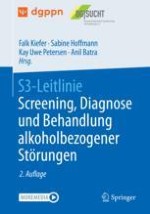Zusammenfassung
Der Konsum von Alkohol, Tabak und Medikamenten ist in unserer Gesellschaft allgegenwärtig und wird weitgehend akzeptiert, auch wenn dieser mit einer Vielzahl von gesundheitlichen und sozialen Folgen verbunden ist. In Deutschland trinkt jeder Einwohner/jede Einwohnerin über 15 Jahre im Durchschnitt 11 Liter reinen Alkohol pro Jahr (John & Hanke, 2018). Die Empfehlungen für risikoarmen Alkoholkonsum der Weltgesundheitsorganisation (WHO), welche auch die Bundeszentrale für gesundheitliche Aufklärung (BZgA) unterstützt, liegen bei weniger als 24 g reinen Alkohol für Männer und 12 g reinen Alkohol für Frauen pro Tag. Dies entspricht zwei bzw. einem Standardgetränk/en (z. B. ein kleines Glas Bier) (Kalinowski & Humphreys, 2016). In Analogie zu diesen Richtwerten konsumieren 18,1 % der deutschen Erwachsenen Alkohol in riskanten Mengen. Nach dem klinischen Diagnostikinstrument DSM-IV erfüllten 2,8 % der erwachsenen Bevölkerung die Kriterien für schädlichen Alkoholkonsum und 3,1 % die Kriterien für eine Alkoholabhängigkeit (Atzendorf et al., 2019).











